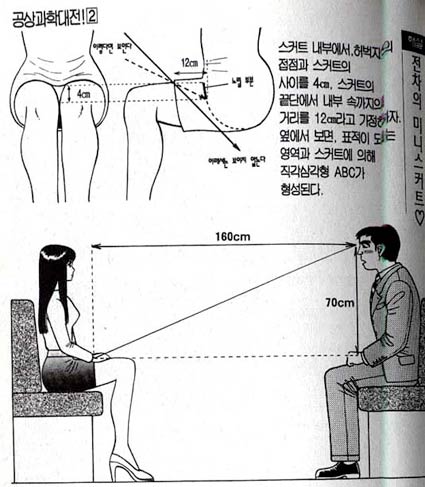science

Does Hysterical Strength Really Exist?
You hear about cases every so often: a mother lifting a car to rescue a pinned child, performing a feat of strength not usually available to humans. Evidence is almost always anecdotal — like when a man in Arizona lifted a car to free a cyclist who’d been hit and dragged in 2006, witnessed only by those involved in the accident — but these things happen so rarely (if they do indeed happen at all) that it’s difficult to observe them under repeatable, scientific circumstances. But while proof of the events themselves remains hearsay, there is a theory, at least, among researchers that such things are at least possible.
It’s all about adrenaline. (…)
“When adrenaline is released by the adrenal medulla — an interior region of the adrenal glands, which are located just above your kidneys — it allows blood to flow more easily to your muscles. This means that more oxygen is carried to your muscles by the extra blood, which allows your muscles to function at elevated levels.”
{ Mental Floss | Continue reading }
science | April 18th, 2011 6:40 pm

By asking a group of older adults to analyze videos of other people conversing — some talking truthfully, some insincerely — a group of scientists at the University of California, San Francisco has determined which areas of the brain govern a person’s ability to detect sarcasm and lies.
Some of the adults in the group were healthy, but many of the test subjects had neurodegenerative diseases that cause certain parts of the brain to deteriorate. The UCSF team mapped their brains using magnetic resonance imaging, MRI, which showed associations between the deteriorations of particular parts of the brain and the inability to detect insincere speech.
{ UCSF | Continue reading }
brain, relationships | April 18th, 2011 3:56 pm
animals, flashback, photogs, science | April 18th, 2011 3:44 pm

…study by Richard Wiseman, a psychologist at the University of Hertfordshire. Wiseman surveyed a number of people and, through a series of questionnaires and interviews, determined which of them considered themselves lucky—or unlucky. He then performed an intriguing experiment: He gave both the “lucky” and the “unlucky” people a newspaper and asked them to look through it and tell him how many photographs were inside. He found that on average the unlucky people took two minutes to count all the photographs, whereas the lucky ones determined the number in a few seconds.
How could the “lucky” people do this? Because they found a message on the second page that read, “Stop counting. There are 43 photographs in this newspaper.” So why didn’t the unlucky people see it? Because they were so intent on counting all the photographs that they missed the message.
Wiseman noted, “Unlucky people miss chance opportunities because they are too focused on looking for something else. They go to parties intent on finding their perfect partner, and so miss opportunities to make good friends. They look through the newspaper determined to find certain job advertisements and, as a result, miss other types of jobs. Lucky people are more relaxed and open, and therefore see what is there, rather than just what they are looking for.”
{ Erik Calonius | Continue reading }
artwork { Andy Warhol, Dance Diagram, 1962 }
guide, psychology | April 18th, 2011 3:29 pm

Humpback whales have their own version of the hit single, according to a new study. At any given time within a population, male humpbacks all sing the same mating tune. But the pattern of the song changes over time, with the new and apparently catchy versions of the song spreading repeatedly across the ocean, almost always traveling from west to east. (…)
This is the first time that such broad-scale and population-wide cultural exchange has been documented in any species other than humans, she added.
{ EurekAlert | Continue reading }
animals, music, science | April 18th, 2011 3:23 pm

You know how when you’re in an elevator or an underground train, everybody seems to try their darnedest not to look anyone else in the eye. This everyday experience completely contradicts hundreds of psychology studies conducted in the lab, which show how rapidly our attention is drawn to other people’s faces and especially their eyes.
Why the contradiction? Because psychologists have used pared down, highly controlled situations to study where people look, often involving faces and social scenes presented on a computer screen. And crucially, when participants look at a monitor, they generally know that the other person can’t look back. (…)
“Through the simple act of introducing the potential for social interaction, visual behaviour changed dramatically,” the researchers said.
{ BPS | Continue reading }
psychology, relationships | April 18th, 2011 3:20 pm

Tech bubbles happen, but we usually gain from the innovation left behind. This one—driven by social networking—could leave us empty-handed
As a 23-year-old math genius one year out of Harvard, Jeff Hammerbacher arrived at Facebook when the company was still in its infancy. This was in April 2006, and Mark Zuckerberg gave Hammerbacher—one of Facebook’s first 100 employees—the lofty title of research scientist and put him to work analyzing how people used the social networking service. Specifically, he was given the assignment of uncovering why Facebook took off at some universities and flopped at others. The company also wanted to track differences in behavior between high-school-age kids and older, drunker college students. “I was there to answer these high-level questions, and they really didn’t have any tools to do that yet,” he says.
Over the next two years, Hammerbacher assembled a team to build a new class of analytical technology. His crew gathered huge volumes of data, pored over it, and learned much about people’s relationships, tendencies, and desires. Facebook has since turned these insights into precision advertising, the foundation of its business. (…)
After a couple years at Facebook, Hammerbacher grew restless. He figured that much of the groundbreaking computer science had been done. Something else gnawed at him. Hammerbacher looked around Silicon Valley at companies like his own, Google, and Twitter, and saw his peers wasting their talents. “The best minds of my generation are thinking about how to make people click ads,” he says. “That sucks.” (…)
Hammerbacher quit Facebook in 2008, took some time off, and then co-founded Cloudera, a data-analysis software startup. He’s 28 now and speaks with the classic Silicon Valley blend of preternatural self-assurance and save-the-worldism. (…) He’s not really a programmer or an engineer; he’s mostly just really, really good at math. (…)
On Wall Street, the math geeks are known as quants. They’re the ones who create sophisticated trading algorithms that can ingest vast amounts of market data and then form buy and sell decisions in milliseconds. Hammerbacher was a quant. After about 10 months, he got back in touch with Zuckerberg, who offered him the Facebook job in California. That’s when Hammerbacher redirected his quant proclivities toward consumer technology.
{ BusinessWeek | Continue reading }
economics, experience, science, technology | April 15th, 2011 8:40 am

Physicians may choose riskier treatment for themselves than they’d recommend for their patients, according to a study that highlights a need for candid discussions about patients’ preferences.
The findings are important because patients faced with difficult medical decisions often ask their doctors, “What would you do?” The answer reflects the doctors’ values — not necessarily those of the patient. (…)
The study asked more than 700 primary-care doctors to choose between two treatment options for cancer and the flu — one with a higher risk of death, one with a higher risk of serious, lasting complications.
In each of the two scenarios, doctors who said they’d choose the deadlier option for themselves outnumbered those who said they’d choose it for their patients. (…)
Previous research shows many people would react in a similar emotional way when presented with difficult choices for themselves versus others.
For example, one study asked participants if they would approach an attractive stranger in a bar if they noticed that person was looking at them. Many said no, but they would give a friend the opposite advice. Saying “no” meant avoiding short-term pain — possible rejection by an attractive stranger — but also missing out on possible long-term gain — a relationship with that stranger.
{ News & Records | Continue reading }
screenshots { 1 | 2 }
psychology | April 13th, 2011 5:28 pm

In the present study 24 university students read four different texts in four conditions:
(1) while listening to music they preferred to listen to while studying;
(2) while listening to music they did not prefer to listen to while studying;
(3) while listening to a recording of noise from a café; and finally
(4) in silence.
After each text they took a reading-comprehension test. Eye movement data were recorded for all participants in all conditions.
A main effect for the reading-comprehension scores revealed that the participants scored significantly lower after they had been listening to the non-preferred music while reading, compared with reading in silence.
{ SAGE | Continue reading }
photo { Kyoko Hamada }
music, neurosciences | April 13th, 2011 5:28 pm

Anecdotal reports suggest that some users of ecstasy (MDMA) experience increased feelings of empathy and are more social while under influence of the drug. Such effects may contribute to the timing and frequency of ecstasy use and may also contribute to risk of abuse or dependence. Understanding this phenomenon in more detail might provide clinicians with better strategies to reduce use and the associated complications of ecstasy use.
Studying acute effects of illicit drugs is difficult under natural conditions. Users of ecstasy commonly also use alcohol, nictoine and other illicit drugs in the context of ecstasy use. Isolating psychological effects of one agent in this type of environment is difficult if not impossible. One alternative is to admiinster ecstasy in a laboratory setting with subjects blind to whether ecstasy or placebo is being administered. However, this approach poses significant ethical challenges. One approach, is to limit human study in the lab to those who have previously use ecstasy and intend to continue using. (…)
A study in Biological Psychiatry took this approach when over four sessions, healthy ecstasy using volunteers received either a low or high dose of MDMA, a dose of methamphetamine (METH) or placebo. (…)
Findings suggest MDMA increases social approach (sociability). The study supports the possibility that increased social behavior with MDMA might be due to a reduced sensitivity to negative emotions of others rather than increasing recognition of positive emotions in others.
{ Brain Posts | Continue reading }
photo { Noritoshi Hirakawa }
drugs, neurosciences, photogs, relationships | April 13th, 2011 2:57 pm

A new study from the U.K. confirms the conventional wisdom: friends and exercise make us happy. It also shows how unhappy people drag us down.
{ The Atlantic | Continue reading }
photo { Jim Britt }
marketing, photogs, psychology | April 12th, 2011 4:07 pm

If beautiful people have more daughters, and if physical attractiveness is heritable, then it follows that, over time, women become physically more attractive than men. This indeed appears to be the case.
The logic of the generalized Trivers-Willard hypothesis (gTWH) suggests that physically more attractive parents are more likely to have daughters than physically less attractive parents. (…)
Earlier studies indeed show that women are on average physically more attractive than men both in Japan and in the United States. Analysis of the NCDS data now replicates the sex difference in physical attractiveness in the United Kingdom.
{ PsychologyToday | Continue reading }
genders, science | April 12th, 2011 3:50 pm

{ How food-breaks sway the decisions of judges. The graph above shows that the odds that prisoners will be successfully paroled start off fairly high at around 65% and quickly plummet to nothing over a few hours (although, see footnote). After the judges have returned from their breaks, the odds abruptly climb back up to 65%, before resuming their downward slide. | Discover | full story }
food, drinks, restaurants, law, psychology | April 12th, 2011 3:28 pm
Forget passwords, tricky sums are more secure
Classic user identification requires the remote user sending a username and a password to the system to which they want to be authenticated. The system looks up the username in its locally stored database and if the password submitted matches the stored password, then access is granted. This method for identification works under the assumption there exist no malicious users and that their local terminals cannot be infected by malware. (…)

Nikolaos Bardis of the University of Military Education, in Vari, Greece and colleagues there and at the Polytechnic Institute of Kiev, in Ukraine, have developed an innovative approach to logins, which implements the advanced concept of zero knowledge identification.
Zero knowledge user identification solves these issues by using passwords that change for every session and are not known to the system beforehand. The system can only check their validity.
{ ScienceText | Continue reading }
mathematics, spy & security, technology | April 12th, 2011 3:17 pm

Suicide Gene Identified
The study evaluated the entire genomes of patients with bipolar disorder who had attempted suicide (n=1201) and those who had not (n=1497). In total, there were more than 2500 regions located on various chromosomes that showed significant associations with suicidal behavior. The strongest association was with a region on chromosome 2 containing the ACP1 gene. This gene encodes for a signaling protein (tyrosine phosphatase) produced in the brain.
{ BrainBlogger | Continue reading }
photo { Sophia Wallace }
genes, science | April 12th, 2011 3:00 pm

In recent years several studies have suggested that women’s voices change at different times over the menstrual cycle, with the tone rising as ovulation approaches.
Now a study conducted by researchers at the West Texas A&M University in which women’s voices were subjected to computerized acoustical analysis contradicts those findings.
After assessing 175 samples provided by 35 study participants at various points throughout the menstrual cycles, the researchers say that changes in hormonal status have no significant impact on eight distinct voice parameters.
{ EurekAlert | Continue reading }
photo { Zev Jonas }
genders, horse, science | April 11th, 2011 8:53 pm

A study found that pigeons recognize a human face’s identity and emotional expression in much the same way as people do.
Pigeons were shown photographs of human faces that varied in the identity of the face, as well as in their emotional expression — such as a frown or a smile. In one experiment, pigeons, like humans, were found to perceive the similarity among faces sharing identity and emotion. In a second, key experiment, the pigeons’ task was to categorize the photographs according to only one of these dimensions and to ignore the other. The pigeons found it easier to ignore emotion when they recognized face identity than to ignore identity when they recognized face emotion.
{ EurekAlert | Continue reading }
images { 1 | 2. Shomei Tomatsu }
birds, science | April 11th, 2011 8:51 pm

Near-Earth asteroid 2005 YU55 will pass within 0.85 lunar distances from the Earth on November 8, 2011.
The upcoming close approach by this relatively large 400 meter-sized, C-type asteroid presents an excellent opportunity for synergistic ground-based observations including optical, near infrared and radar data.
The attached animated illustration shows the Earth and moon flyby geometry for November 8th and 9th when the object will reach a visual brightness of 11th magnitude and should be easily visible to observers in the northern and southern hemispheres. (…)
Although classified as a potentially hazardous object, 2005 YU55 poses no threat of an Earth collision over at least the next 100 years.
However, this will be the closest approach to date by an object this large that we know about in advance and an event of this type will not happen again until 2028 when asteroid (153814) 2001 WN5 will pass to within 0.6 lunar distances.
{ NASA | Continue reading }
photo { Alex Prager }
space | April 11th, 2011 3:01 pm

Key genital measurement linked to male fertility
The dimension in question is not penis or testicle size, but a measurement known as anogenital distance, or AGD.
That distance, measured from the anus to the underside of the scrotum, is linked to male fertility, including semen volume and sperm count, the study found. The shorter the AGD, the more likely a man was to have a low sperm count. (…)
Phthalates are a group of chemicals widely used in industrial and personal care products, including fragrances, shampoos, soaps, plastics, paints and some pesticides.
Scientists tested for the presence of phthalates in the pregnant women’s urine. They found that women who had high levels of phthalates in their urine during pregnancy gave birth to sons who were 10 times more likely to have shorter than expected AGDs.
{ Reuters | Continue reading }
health, science | April 11th, 2011 3:01 pm

{ Sandro Botticelli, Primavera, ca. 1482 | Enlarge/Zoom | There are 500 identified plant species depicted in the painting, with about 190 different flowers. Of the 190 different species of flowers depicted, at least 130 have been specifically named. | Wikipedia | Continue reading }
Botany, art | April 9th, 2011 9:42 am






















